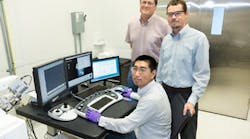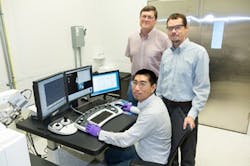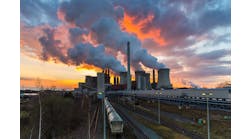A future based on low carbon economics is going to rely on technologies that provide innovative ways of dealing with carbon dioxide, the most-prevalent greenhouse gas. One of the fastest growing areas is the use of novel catalysts to convert the waste gas into useful fuels and chemicals.
Industrial interest in such catalysts definitely is growing. An important indication of this is the formation late last year of CO2 Value Europe, Brussels, Belgium. Its mission is to promote the development and market deployment of sustainable industrial technologies that convert carbon dioxide into valuable products — in particular, as a source of non-fossil feedstock for the chemical industry. Already, 43 industrial and research organizations, including Solvay and Praxair, have signed up.
The organization’s president, Stefanie Kesting, put its aims into context: “The responsible management of carbon dioxide emissions is one of the burning topics of our days. Converting it into sustainable chemicals, fuels or other materials has enormous potential and now reaches the maturity level which is needed for real impact. Therefore, we want to leverage the collective intelligence of our members across the traditional boundaries of industrial sectors to identify which carbon capture and use technologies make the most sense from both a climate and economic perspective, and how those can be brought to market at a large scale.”
Progress in catalysis underpins such initiatives. Here’s a rundown on some notable developments.
Fortuitous Find
At the U.S. Department of Energy’s Oak Ridge National Laboratory (ORNL), Oak Ridge, Tenn., scientists are taking advantage of a chance discovery in October 2016. At that time, the team was working with a catalyst made of carbon, copper and nitrogen. A voltage applied to a solution containing the catalyst, together with carbon dioxide dissolved in water, resulted in a mixture containing mainly ethanol with a yield of 63%.
“We’re taking carbon dioxide, a waste product of combustion, and we’re pushing that combustion reaction backwards with very high selectivity to a useful fuel. Ethanol was a surprise — it’s extremely difficult to go straight from carbon dioxide to ethanol with a single catalyst,” noted Adam Rondinone, senior staff scientist at the ORNL Center for Nanophase Materials Sciences, at the time.
Figure 1. Yang Song (seated), Dale Hensley (standing left) and Adam Rondinone examine a carbon nanospike sample with a scanning electron microscope. Source: Genevieve Martin/Oak Ridge National Laboratory, U.S. Dept. of Energy.
Investigations revealed that the catalyst’s novel performance stems from its nanoscale structure, which consists of copper nanoparticles embedded in carbon spikes (Figure 1). It also was found that this nano-texturing approach obviates expensive or rare metals such as platinum that limit the economic viability of many catalysts.
Since then, the team has been working to improve the catalyst’s performance.
“It’s still the same catalyst, although we have made changes to how it is synthesized in order to lower the cost and improve durability. Although we can’t divulge the details of those improvements yet, we are confident that the catalyst will last long enough in a commercial setting to be useful. We have also removed the silicon wafer that was used as a substrate in 2016,” says Rondinone.
The 63% yield of ethanol remains the same. However, Rondinone believes improvement will be possible when a larger system that can recycle byproducts such as hydrogen and carbon monoxide is engineered. “We have improved the activity of the catalyst, or the ‘current density’ so that it essentially works faster, although there is still a lot more work to be done on that topic,” he adds.
Another topic under investigation is deliberately making the heavier hydrocarbons that sometimes now appear, although not in high amounts, in the reaction product. “The ability to see heavier products suggests that a pathway is there, if we can find a way to exploit it,” he notes.
Alongside this ongoing chemistry work, the team also has spent the last year studying and working to improve the application of the catalyst in an industrial setting.
“This is a very different project from the basic science work. For industrial application, we need to understand the durability and tolerance of the catalyst for contamination, and we need to make it large and cheaper than lab scale, and we need to get the current density as high as possible in order to minimize capital cost. There are many different approaches to understanding and mitigating the challenges of commercial application, and while we’ve made progress, we still have room for improvement,” explains Rondinone.
He reckons the group is about a year from the transfer of the technology into a commercial lab, and that technical developments still will be needed after that point:“A small-scale pilot could be initiated within a year, if things continue to go well.”
The catalyst could have great potential when using stored electricity generated by wind and solar power, the team believes. A recent study carried out by the Tippie College of Business at the University of Iowa, Iowa City, Iowa, concluded that the wind farm approach in particular has great business promise, but it also identified areas needing improvement first.
Rondinone describes the industrial interest in the department’s catalyst work as considerable, with multiple organizations keen to commercialize the technology; he can’t reveal their identities until contracts are signed.
In the meantime, the ORNL scientists also are looking at a variety of other approaches for converting electricity into chemicals using electrocatalysis. “In order to lower the consumption of fossil carbon in the future, we’ll need ways to convert renewable electricity into a range of products necessary for modern life — ethanol is an example of a fuel but there are many other needs. One area of interest for our team is the conversion of nitrogen gas to ammonia using electrochemistry. If this can be done at a large scale, then we can possibly eliminate methane steam reforming from the process and the associated carbon dioxide emissions,” he explains.
Structure-Changing Catalyst
Meanwhile, scientists at the U.S. Department of Energy’s Lawrence Berkeley National Laboratory, Berkeley, Calif., have created an electrocatalyst that converts carbon dioxide into multi-carbon fuels and alcohols using very low levels of energy.
The electrocatalyst itself is made of copper nanoparticles and, under the right conditions, breaks down carbon dioxide to form ethylene, ethanol and propanol. It consists of tightly packed, densely layered 7-nm-diameter copper spheres. During the early period of electrolysis, clusters of these nanoparticles fuse to transform into cube-like nanostructures with diameters of 10–40 nm.
This real-time structural change from copper nanospheres to the cube-like structures facilitates the formation of multi-carbon hydrocarbons and oxygenates, but quite how this happens remains a mystery. “The cube-like shapes and associated interface may be providing an ideal meeting place where the carbon dioxide, water and electrons come together,” speculates Peidong Yang, a professor in the University of California –Berkeley’s department of materials science and engineering.
The ORNL researchers and Berkeley scientists believe the catalyst could be hooked up to a variety of renewable energy sources. For example, if this catalyst were incorporated into an electrolyzer as part of a solar fuel system, 10cm2ofmaterial would produce about 1.3g of ethylene, 0.8g of ethanol and 0.2g of propanol daily, they estimate.
“With continued improvements in individual components of a solar fuel system, these numbers should keep improving with time,” adds Yang.
Reforming Catalysts
Researchers at the department of chemical and process engineering at theUniversity of Surrey, Guildford, U.K., are focusing on two different uses of carbon dioxide: one to make syngas and the other to produce methane.
To make syngas, the researchers have developed a series of advanced Ni-Sn/Al2O3 and Ni-Sn/CeO2-Al2O3 catalysts for the chemical recycling of carbon dioxide via both bi-reforming of methane, which uses carbon dioxide and steam in the reaction, and dry reforming of methane, which replaces steam with oxygen.
The group now has patented a family of more than 20 new catalysts, all with similar structures but with varying amounts of active phase and promoter chemicals in their composition.
Three non-disclosure agreements (NDAs) have been signed, two with companies in the energy and transportation sector and the third with a company in the catalyst field. The NDAs allow the companies access to the researchers’ progress on catalytic carbon dioxide technologies while giving the researchers access to the specifications of catalysts used by the companies.
“Essentially, they want to explore if our materials show potential for commercialization. This is a nice interaction for both academics and industrial partners since we get first-hand info regarding commercialization and they get the very latest data produced in our lab. Also, it is a nice synergy since we can adapt our experiments to the company’s needs,” explains Tomas Ramirez Reina, leader of the department’s catalysis unit.
The Surrey group now is holding preliminary conversations with an (unnamed) engineering construction company to take the work to pilot-plant scale, he reveals.
The group’s second focus, on the conversion of carbon dioxide to synthetic natural gas via a methanation reaction with hydrogen, has led to development of a series of innovative catalysts based on nickel particles supported on oxides of cerium and zirconium. Tests show that promoters, including oxides of iron and oxides of cobalt, can boost the performance of the catalysts.
“This approachfits within the concept of “power to gas,” which basically aims to produce methane from carbon dioxide using renewable hydrogen from solar or wind sources. One of the main limitations to this technology becoming commercial has been the methanation catalyst. However, the catalysts developed by our team have overcome this,” adds Reina.
The cobalt-boosted catalysts in particular have potential for industrial use. “Since this catalyst operates at high space velocities — and typically the higher the space velocity, the smaller the reactor size — this will involve good savings in terms of capital cost. We could potentially design relatively small—or compact— methanation units and this is useful for flexible applications,” he notes.
However, one challenge is adapting the technology so that it can be connected to flue gases. These typically contain NOx and SOx that could damage catalyst performance.
“Also from the engineering perspective, working with recycling streams will be another challenge to overcome. However, I have a multidisciplinary team of both chemical engineers and chemists and we are working on this,” he says.
Interestingly, Reina says this particular family of catalysts won’t be patented because the team now is pursuing yet another area of research. “This could be more promising, although we are still waiting for more results. However, we have learned a lot with these cobalt-promoted catalysts and we are using this knowledge to develop the next generation of powerful catalysts for carbon dioxide conversion to methane. We are aiming for these to have an impact in the power to gas technology market.”
The department also is working on a variety of collaborative European projects and has won a Global Challenge grant from the U.K. Engineering and Physical Sciences Research Council to mitigate global warming in Latin America. The latter involves teaming up with researchers from Brazil, Columbia, Argentina and others to develop world-class carbon dioxide capture and utilization technologies.
Feedstock Focus
Also in the U.K., the department of chemistry at the University of York, York, is focusing its efforts on using carbon dioxide as a chemical feedstock. In particular, the department is working on catalysts that allow transformations to occur at or near room temperature and atmospheric pressure. Its researchers already have developed aluminium-based catalysts for reacting epoxides and carbon dioxide to form cyclic carbonates; the conversion occurs at room temperature in a batch reactor or at 100°C using immobilized catalysts in a gas-phase flow reactor.
York researchers also are investigating the potential of photocatalytic reduction of carbon dioxide for solar-based fuels production. The challenge here is to overcome the poor efficiency, instability or toxicity of current catalyst systems.
Efforts center on forming nanocomposite photocatalysts made of cobalt/aluminium layered nanosheets combined with titanium dioxide nanotubes or nanoparticles; the nanosheets absorb visible light, the titanium dioxide nanotubes absorb UV light, and the interface between them acts synergistically. The nanocomposite photocatalyst offers an up-to-ten-fold improvement over results achieved separately by the components. The researchers believe such a strategy could be cost-effective for aqueous-phase carbon dioxide reduction.




